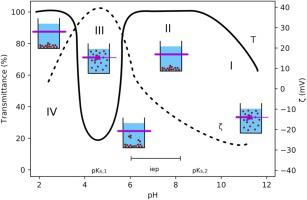当前位置:
X-MOL 学术
›
Colloids Surf. A Physicochem. Eng. Aspects
›
论文详情
Our official English website, www.x-mol.net, welcomes your
feedback! (Note: you will need to create a separate account there.)
A CONCEPTUAL MODEL FOR STABILITY AND SURFACE CHEMISTRY OF OXIDIC SOIL DISPERSIONS
Colloids and Surfaces A: Physicochemical and Engineering Aspects ( IF 4.9 ) Pub Date : 2020-10-01 , DOI: 10.1016/j.colsurfa.2020.125214 Tairone Paiva Leão , Helen Vieira Neves , Alex Fabiano Cortez Campos , Thamires Dutra Pinheiro , Cícero Célio de Figueiredo
Colloids and Surfaces A: Physicochemical and Engineering Aspects ( IF 4.9 ) Pub Date : 2020-10-01 , DOI: 10.1016/j.colsurfa.2020.125214 Tairone Paiva Leão , Helen Vieira Neves , Alex Fabiano Cortez Campos , Thamires Dutra Pinheiro , Cícero Célio de Figueiredo

|
Abstract Stability of soil dispersions has a wide range of environmental and engineering applications and implications, such as in natural water chemistry and treatment, soil degradation and loss, and contamination of water sources by sedimentation. The main objectives of this study were to enhance the understanding of the relationship between surface chemistry and stability of oxidic soils dispersions, and to propose a conceptual model to describe this relationship. The coagulation-dispersion behavior of three soils with high content of clay sized natural Fe and Al oxides, classified as Rhodic Ferralsol (RF), Xanthic Ferralsol (XF), and Dystric Gleysol (GL), was investigated using a qualitative approach to the EDL-DVLO theory coupled with the two-pK model. Each soil sample was divided into two groups, one of each was subjected to organic matter removal. Subsamples were used for the determination of zeta potential (ζ), transmittance from UV–vis spectroscopy and potentiometric-conductometric titration, all in NaOH 1 mol L−1 aqueous dispersions with pH adjusted using HCl 1 mol L−1. A descriptive model for the stability of Fe and Al oxides rich soil colloids is introduced. The proposed qualitative model is divided into four regions, each corresponding to a combination of pH, transmittance and ζ. Region I, at pH values from 12 to pKs,2, corresponds to a stable dispersion. Region II corresponds to a region of coagulation around the isoelectric point with pH ranging from pKs,2 to around 6. Region III from pH around 6 to 4, centered on pKs,1, corresponds to a stable dispersion driven by high ζ. Region IV from pHs around 4 to 2 corresponds to coagulated solution.
中文翻译:

氧化性土壤分散体稳定性和表面化学的概念模型
摘要 土壤分散体的稳定性具有广泛的环境和工程应用和影响,例如在天然水化学和处理、土壤退化和流失以及沉积对水源的污染。本研究的主要目的是加深对表面化学与氧化性土壤分散体稳定性之间关系的理解,并提出一个概念模型来描述这种关系。使用 EDL 的定性方法研究了具有高含量粘土大小的天然 Fe 和 Al 氧化物的三种土壤的混凝分散行为,这些土壤分类为 Rhodic Ferralsol (RF)、Xanthic Ferralsol (XF) 和 Dystric Gleysol (GL) -DVLO 理论与双 pK 模型相结合。每个土壤样品分为两组,每一种都进行了有机物去除。子样品用于测定 zeta 电位 (ζ)、UV-vis 光谱和电位-电导滴定的透射率,均在 NaOH 1 mol L-1 水分散体中,pH 值使用 HCl 1 mol L-1 调节。介绍了富含铁和铝氧化物的土壤胶体稳定性的描述模型。提出的定性模型分为四个区域,每个区域对应于 pH、透射率和 ζ 的组合。区域 I,pH 值从 12 到 pKs,2,对应于稳定的分散体。区域 II 对应于等电点周围的凝固区域,pH 范围从 pKs,2 到 6 左右。区域 III 从 pH 值在 6 到 4 左右,以 pKs,1 为中心,对应于由高 ζ 驱动的稳定分散。
更新日期:2020-10-01
中文翻译:

氧化性土壤分散体稳定性和表面化学的概念模型
摘要 土壤分散体的稳定性具有广泛的环境和工程应用和影响,例如在天然水化学和处理、土壤退化和流失以及沉积对水源的污染。本研究的主要目的是加深对表面化学与氧化性土壤分散体稳定性之间关系的理解,并提出一个概念模型来描述这种关系。使用 EDL 的定性方法研究了具有高含量粘土大小的天然 Fe 和 Al 氧化物的三种土壤的混凝分散行为,这些土壤分类为 Rhodic Ferralsol (RF)、Xanthic Ferralsol (XF) 和 Dystric Gleysol (GL) -DVLO 理论与双 pK 模型相结合。每个土壤样品分为两组,每一种都进行了有机物去除。子样品用于测定 zeta 电位 (ζ)、UV-vis 光谱和电位-电导滴定的透射率,均在 NaOH 1 mol L-1 水分散体中,pH 值使用 HCl 1 mol L-1 调节。介绍了富含铁和铝氧化物的土壤胶体稳定性的描述模型。提出的定性模型分为四个区域,每个区域对应于 pH、透射率和 ζ 的组合。区域 I,pH 值从 12 到 pKs,2,对应于稳定的分散体。区域 II 对应于等电点周围的凝固区域,pH 范围从 pKs,2 到 6 左右。区域 III 从 pH 值在 6 到 4 左右,以 pKs,1 为中心,对应于由高 ζ 驱动的稳定分散。











































 京公网安备 11010802027423号
京公网安备 11010802027423号